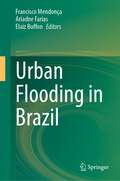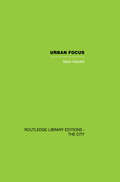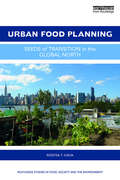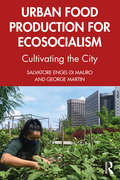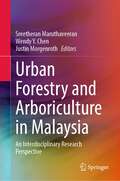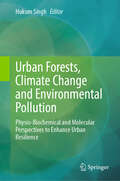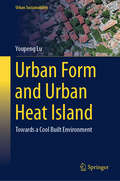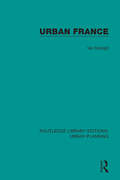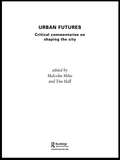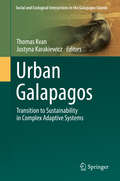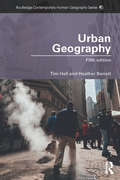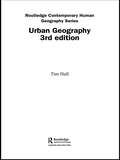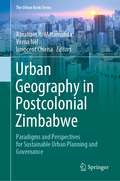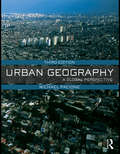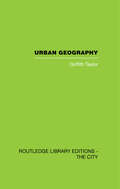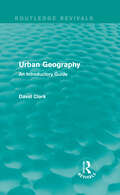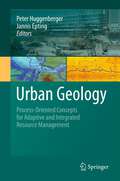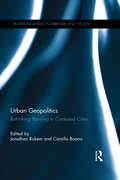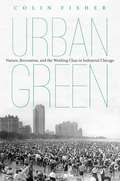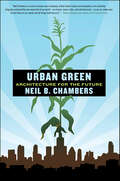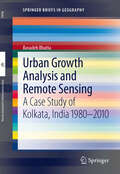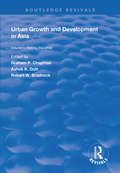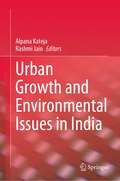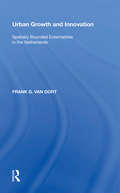- Table View
- List View
Urban Flooding in Brazil
by Francisco Mendonça Ariadne Farias Elaiz BuffonThis contributed volume analyzes flooding scenarios in Brazilian cities using a geographic and spatiotemporal approach to explore impacts and ways to mitigate future disasters. The problem of urban flooding is growing in Brazilian cities due to the increasing number of natural disasters in the context of global climate change; this is a topic that poses challenges to urban planners and academics. Through three sections, this volume offers theoretical-conceptual, methodological and technical case studies, as well as cases that explore urban socio-environmental problems associated with flooding. Throughout the book, the concepts of risk, vulnerability and adaptation are used to explore future flood scenarios in Brazil.The integrated vision offered in this volume covers the floods themselves, evaluation of flood impacts, and the management process before, during, and after the flood event. The case studies presented here elucidate the concept of comprehensive urban flood management, offering a technical and diagnostic basis for the problem in different cities in Brazil. The present and future challenges presented by these chapters offer widely-transferable lessons that can be applied to making cities around the world more sustainable and disaster-resilient.
Urban Focus
by Mark HewlettThis project is aimed the 16+ age range inside or outside any kind of educational institution. It is for courses concerned with general education - either in general studies programmes or as aspects of specialist teaching. Narrative has been kept to a minimum. Instead, the books are more a collection of different items of teaching and learning materials: for example, the collection of key concepts, and the list of key questions connected withe the study. The books are compact in content and flexible in use. This book was first published in 1974.
Urban Food Planning: Seeds of Transition in the Global North (Routledge Studies in Food, Society and the Environment)
by Rositsa T. IlievaThis highly original work examines the rise of the urban food planning movement in the Global North and provides insights into the new relationship between cities and food which has started developing over the past decade. It sheds light on cities as new spaces for food system innovation and on food as a tool for sustainable urban development. Drawing insights from the literature on socio-technical transitions, the book presents examples of pioneering urban food planning endeavours from North America and Western Europe (especially the Netherlands and the UK). These are integrated into a single mosaic helping to uncover the conceptual, analytical, design, and organizational innovations emerging at the interface of food and urban policy and planning. The author shows how promising "seeds of transition" to a shared urban food planning agenda are in the making, though the urban food planning niche as a whole still lacks the necessary maturity to lastingly influence mainstream planning practices and the dominant agri-food system regime. Some of the strategic levers to cope with the current instability and limitations of urban food planning and effectively transition it from a marginal novelty to a normalized domain of policy, research, and practice are systematically examined to this end. The conclusions and recommendations put forward have major implications for scholars, activists, and public officials seeking to radically transform the co-evolution of food, cities, and the environment.
Urban Food Production for Ecosocialism: Cultivating the City
by George Martin Salvatore Engel-Di MauroThis book explores the critical role of urban food production in strengthening communities and in building ecosocialism. It integrates theory and practice, drawing on several local case studies from seven countries across four continents: China, Cuba, Ghana, Italy, Tanzania, the UK, and the US. Research shows that the term "urban agriculture" overstates the limited food-growing potential in cities due to a shortage of land required for growing grains, the basic human food staple. For this reason, the book suggests "urban cultivation" as an appropriate term which indicates social and political progress achieved through combined labours of urbanites to produce food. It examines how these collaborative food-growing efforts help raise local social capital, foster community organisation, and create ecological awareness in order to promote urban food production while also ensuring environmental sustainability. This book illustrates how urban cultivation constitutes a potentially important aspect of urban ecosystems, as well as offers solutions to current environmental problems. It recentres attention to the global South and debunks Eurocentric narratives, challenging capitalist commercial food-growing regimes and encouraging ecosocialist food-growing practices. Written in an accessible style, this book is recommended reading about an emergent issue which will interest students and scholars of environmental studies, geography, sociology, urban studies, politics, and economics.
Urban Forestry and Arboriculture in Malaysia: An Interdisciplinary Research Perspective
by Sreetheran Maruthaveeran Wendy Y. Chen Justin MorgenrothThis book represents the latest research on urban forestry in a Malaysian context. It demonstrates that urban forestry is concerned not only with environmental enhancement, but also other aspects, such as recreation, health and well-being, and government policies. This edited collection provides a comprehensive overview of urban forestry studies from various researchers in Malaysia, and includes rich historical perspectives of urban forestry in the country. It also tackles related issues in policy. The greening of urban Malaysia in the 1970s focused primarily on beautification and was primarily the province of horticulturists, landscapers, nursery workers, town planners, and architects, with negligible inputs from foresters, particularly urban foresters. Perhaps for that reason, the term “landscaping” has been used more widely than “urban forestry” by government and private institutions, politicians, stakeholders, academicians, and the public. Nevertheless, the authors show that the concept of urban forestry is not new for developing countries such as Malaysia, where urbanization is increasing at a rapid rate. The book unpacks this demographic shift from a predominantly rural to a principally urban society. As the only unified body of work on urban forestry and arboricultural studies in Malaysia, this volume presents an important interdisciplinary reference for students, researchers, and scholars in physical geography, forestry and urban forestry, arboriculture and landscape architecture, both in Malaysia, and in other developing urbanizing countries, particularly in Southeast Asia. It is also an important resource for those working in environmental policy and practice, excavating the vital connection between the environment and well-being.
Urban Forests, Climate Change and Environmental Pollution: Physio-Biochemical and Molecular Perspectives to Enhance Urban Resilience
by Hukum SinghThis book contributes significantly to the international literature by bringing forth a novel and comprehensive exploration of urban resilience in the face of climate change and environmental pollution. Its focus on integrating physiological, biochemical, and molecular dimensions distinguishes it from existing literature. The book offers several key contributions, including an interdisciplinary approach to understanding the complex interactions within urban ecosystems. It includes cutting-edge insights that have not been extensively explored in existing literature, practical applications, and evidence-based strategies to enhance urban sustainability and resilience. The book has a global relevance to a diverse international readership and provides strategic guidance to policymakers and urban planners when making decisions to develop evidence-based strategies that cater to the specific challenges of cities. Urban forests play a critical role in enhancing the resilience of cities by providing numerous benefits, including improved air quality, reduced urban heat island effect, and enhanced biodiversity, ultimately improving urban health. Besides, urban forests are a crucial natural-based solution (NbS) to mitigate air pollution and climate change impacts in cities. However, in the face of climate change and environmental pressures, urban forests face significant challenges to their survival and functionality. This book explores the complex morpho-physio-biochemical and molecular changes that enable urban forests to flourish amidst climate change and environmental pollution. It examines how urban trees modulate their morphological structures, including root systems and physiological and biochemical functioning, and molecular alterations to withstand changing urban climatic and environmental conditions.
Urban Form and Urban Heat Island: Towards a Cool Built Environment (Urban Sustainability)
by Youpeng LuThis book provides a comprehensive exploration of the spatial patterns, drivers, mechanisms and management strategies associated with urban heat islands (UHI). It presents new insights into how urban form shapes the thermal environment of cities, shedding light on previously unexplored aspects of UHI dynamics and urban cooling strategies. The key features of this book include: 1. Comprehensive coverage of the influence of urban form on UHI intensity, from spatial patterns to regulatory strategies. 2. Practical implications and recommendations for urban planning and policy formulation to mitigate UHI effects and enhance urban sustainability. Written for researchers, urban planners, policymakers and environmental practitioners, this book provides valuable insights into understanding and addressing the challenges posed by UHI in rapidly urbanising environments. It is suitable for advanced graduate level courses in urban studies, environmental science and geography.
Urban France (Routledge Library Editions: Urban Planning #19)
by Ian ScargillOriginally published in 1983, Urban France examines the rapid growth in French cities between 1950-1980, and the serious consequences that have followed this rapid growth. This volume examines the nature of this urban explosion and the efforts of planners and others to find solutions to the resultant problems of the post-war period. The book addresses the debates surrounding the urban system, urban planning, housing and land use, retailing, and the inception of new towns.
Urban Futures: Critical Commentaries on Shaping Cities
by Malcolm Miles Tim HallUrban Futures brings together commentaries from a wide range of contemporary disciplines and fields relevant to urban culture, form and society. The book concerns cities in the broadest sense, not just as buildings and spaces, but also as processes and events or sites of occupation, in which meanings are constructed in many ways. The contributors draw on their specialist areas of research to inform current debate, but they also speculate as to how cities will be shaped in the 21st century.Specific areas of research include homeless people's organisations and restoration ecology in brownfield sites in the USA, post-industrial urban landscapes, post-industrial economics, tourism and cultural planning. The book allows each writer to state their own conclusions, but together they suggest that tomorrow's cities will, while remaining locations of difference and contestation, be rapidly evolving systems in which dwellers assume increasing responsibilities and power.
Urban Galapagos: Transition to Sustainability in Complex Adaptive Systems (Social and Ecological Interactions in the Galapagos Islands)
by Thomas Kvan Justyna KarakiewiczThis book addresses the future of urbanisation on the Galapagos Islands from a systems, governance and design perspective with the competing parameters of liveability, economic and ecological, using the Galapagos as a laboratory for the theoretical and postulative understanding of evolving settlement and habitation. The Galapagos islands are one of the world’s most examined and reported examples of a series of naturally evolving ecosystems. The biodiversity of these island ecosystems are the focus of tourism and the image across the world yet human settlement are part of the local ecology. While human intervention is limited, the islands are a distinctive context in which to consider the impact of human habitation as a part of our ecosystems. In this book, authors take the framework of complex adaptive systems (CAS) in which to model systems that grow and evolve, the relations between these various sectors change; systems that get more complex as they evolve. Tested and applied discretely in the two realms of natural and urban, for the first time this text will bring the two together in understanding options for the future of urban settlements on the Galapagos Islands and, by extension, consider how the approach can be used globally in other contexts.
Urban Gardening as Politics (Routledge Equity, Justice and the Sustainable City series)
by Chiara Certomà Chiara TornaghiWhile most of the existing literature on community gardens and urban agriculture share a tendency towards either an advocacy view or a rather dismissive approach on the grounds of the co-optation of food growing, self-help and voluntarism to the neoliberal agenda, this collection investigates and reflects on the complex and sometimes contradictory nature of these initiatives. It questions to what extent they address social inequality and injustice and interrogates them as forms of political agency that contest, transform and re-signify ‘the urban’. Claims for land access, the right to food, the social benefits of city greening/community conviviality, and insurgent forms of planning, are multiplying within policy, advocacy and academic literature; and are becoming increasingly manifested through the practice of urban gardening. These claims are symptomatic of the way issues of social reproduction intersect with the environment, as well as the fact that urban planning and the production of space remains a crucial point of an ever-evolving debate on equity and justice in the city. Amid a mushrooming over positive literature, this book explores the initiatives of urban gardening critically rather than apologetically. The contributors acknowledge that these initiatives are happening within neoliberal environments, which promote –among other things - urban competition, the dismantling of the welfare state, the erasure of public space and ongoing austerity. These initiatives, thus, can either be manifestation of new forms of solidarity, political agency and citizenship or new tools for enclosure, inequality and exclusion. In designing this book, the progressive stance of these initiatives has therefore been taken as a research question, rather than as an assumption. The result is a collection of chapters that explore potentials and limitations of political gardening as a practice to envision and implement a more sustainable and just city.
Urban Geography (Routledge Contemporary Human Geography Series)
by Tim Hall Heather BarrettThis revised fifth edition not only examines the new geographical patterns forming within and between cities, but also investigates the way geographers have sought to make sense of this urban transformation. It is structured into three sections: 'contexts', 'themes' and 'issues' that move students from a foundation in urban geography through its major themes to contemporary and pressing issues. The text critically synthesizes key literatures in the following areas: the urban world changing approaches to urban geography urban form and structure economy and the city urban politics planning, regeneration and urban policy cities and culture architecture and urban landscapes images of the city experiencing the city housing and residential segregation transport and mobility in cities sustainability and the city. This edition builds on the success of the comprehensively revised fourth edition and provides revised chapters on transport/mobility and urban futures, with additional updating of readings and some case studies. The book synthesises a wide range of literature on each subject and presents the material in a lively engaging way, supported by an expanded range of student friendly features, including exercises and suggestions for further study.
Urban Geography (Routledge Contemporary Human Geography Series)
by Tim HallMore than simply examining the new geographical patterns forming within cities, this third edition of Urban Geography also investigates the way geographers have sought to make sense of this urban transformation. Tim Hall critically synthesizes key literatures in the following areas: approaches to urban geography economic geography of the city urban policy new urban forms and landscapes impacts of urban change sustainability and the city. Hall's revised third edition features enhanced pedagogy including boxed discussion points, end of chapter research questions, and an introductory chapter which outlines the importance of urban geography. Additionally a new concluding chapter encourages students to apply what they have read to their own experiences of cities and helps them to apply these ideas to a dissertation. An important volume, this revised edition is an essential read for students and scholars of urban geography.
Urban Geography in Postcolonial Zimbabwe: Paradigms and Perspectives for Sustainable Urban Planning and Governance (The Urban Book Series)
by Innocent Chirisa Abraham R. Matamanda Verna NelThis interdisciplinary book provides a cross-sectoral and multi-dimensional exploration and assessment of the urban geography perspectives in Zimbabwe. Drawing on work from different disciplines, the book not only contributes to academia but also seeks to inform urban policy with the view of contributing to the national aspirations of Zimbabwe attaining middle-income status by 2030. Adopting a multi-dimensional assessment that transcends disciplines such as urban and regional planning, human and physical geography, urban governance, political science, economics and development studies, the book provides a background for co-production concerning urban development in the Global South.The book contributes into its analysis of the institutional and legislative framework that relates to the urban geography of Zimbabwe, as these are responsible for the evolution of the urban system in the country. The connections among different sectors and issues such as environment, economy, politics and the wider objectives of the SDGs, especially goal 11 aspiring to create sustainable communities by 2030, are explored. The success stories relating to urban geography in Zimbabwe are identified together with the best possible practices that may inform urban planning, policy and management.
Urban Geography: A Global Perspective
by Michael PacioneToday, for the first time in the history of Humankind urban dwellers outnumber rural residents. Urban places, towns and cities, are of fundamental importance – for the distribution of population within countries; in the organization of economic production, distribution and exchange; in the structuring of social reproduction and cultural life; and in the allocation and exercise of power. Furthermore, in the course of the present century the number of urban dwellers and level of global urbanisation are destined to increase. Even those living beyond the administrative or functional boundaries of a town or city will have their lifestyle influenced to some degree by a nearby, or even distant, city. The analysis of towns and cities is a central element of all social sciences including geography, which offers a particular perspective on and insight into the urban condition. The principal goal of this third edition of the book remains that of providing instructors and students of the contemporary city with a comprehensive introduction to the expanding field of urban studies. The structure of the first two editions is maintained, with minor amendments. Each of the thirty chapters has been revised to incorporate recent developments in the field. All of the popular study aids are retained; the glossary has been expanded; and chapter references and notes updated to reflect the latest research. This third edition also provides new and expanded discussions of key themes and debates including detailed consideration of metacities, boomburgs, public space, urban sprawl, balanced communities, urban economic restructuring, poverty and financial exclusion, the right to the city, urban policy, reverse migration , and traffic and transport problems. The book is divided into six main parts. Part one outlines the field of urban geography and explains the importance of a global perspective. Part two explores the growth of cities from the earliest times to the present day and examines the urban geography of the major world regions. Part three considers the dynamics of urban structure and land use change in Western cities. Part four focuses on economy, society and politics in the Western city. In part five attention turns to the urban geography of the Third World, where many of the countries experiencing highest rates or urban growth are least well equipped to respond to the economic, social, political and environmental challenge. Finally part six affords a prospective on the future of cities and cities of the future. New to this edition are: further readings based on the latest research; updated data and statistics; an expanded glossary; new key concepts; additional study questions; and a listing of useful websites. The book provides a comprehensive interpretation of the urban geography of the contemporary world. Written in a clear and readable style, lavishly illustrated with more than eighty photographs, 180 figures, 100 tables and over 200 boxed studies and with a plethora of study aids Urban Geography: A Global Perspective represents the ultimate resource for students of urban geography.
Urban Geography: A Study of Site, Evolution, Patern and Classification in Villages, Towns and Cities
by Griffith TaylorThis book is divided into three parts. The first deals with typical settelements in each of the seven continents, the early stages of settlements, land surveys and general phases of town evolution. The second part discusses changes in site and patter, from Neolithic to modern times. The third part specializes in topographic and functional controls in modern towns. Chapters on Planning, Regional Surveys and Classification of towns close the book. There are about 300 specially drawn plans and diagrams of towns - which should appeal to the sociologist and town planner as well as to every serious student of geography. This book was first published in 1949.
Urban Geography: An Introductory Guide (Routledge Revivals)
by David ClarkThis book, first published in 1982, addressed the need for a fresh and comprehensive guide to the rapidly expanding area of urban geography. Drawing on examples from cities in a number of countries, including the U.S.A., David Clark outlines the contribution of geographers to the understanding of the city and urban society, and analyses the growth of the urban environment alongside planning and policy. A thorough and unique study, this title will be of particular value to undergraduate students, as well as laying the foundations for a more advanced study in urban geography and planning.
Urban Geology
by Peter Huggenberger Jannis EptingUrban subsurface resources and particularly urban groundwater are vulnerable to environmental impacts, and their rational management is of major importance. In this book a multidisciplinary team of specialists and scientists presents innovative process-oriented approaches to the sustainable use of these resources. The included case studies from northwestern Switzerland describe representative environments and are relevant for urban areas in general. They illustrate the protection of groundwater; river restoration; engineering and hydrogeological questions related to urban infrastructure and management concepts; as well as monitoring, modeling and remediation strategies for contaminated sites; problems caused by karst in urban environments; the use of shallow geothermal energy; and natural hazards such as flood events and earthquakes. It is demonstrated that modern quantitative earth sciences can contribute significantly in finding solutions concerning the sustainable use of subsurface resources in urban environments. The book is an invaluable source of information for hydrogeologists, geologists, urban planners, water supply engineers, and environmental agencies.
Urban Geopolitics: Rethinking Planning in Contested Cities (Routledge Studies in Urbanism and the City)
by Camillo Boano Jonathan RokemIn the last decade a new wave of urban research has emerged, putting comparative perspectives back on the urban studies agenda. However, this research is frequently based on similar case studies on a few selected cities in America and Europe and all too often focus on the abstract city level with marginal attention given to particular local contexts. Moving away from loosely defined urban theories and contexts, this book argues it is time to start learning from and compare across different ‘contested cities’. It questions the long-standing Euro-centric academic knowledge production that is prevalent in urban studies and planning research. This book brings together a diverse range of international case studies from Latin America, South and South East Asia, Eastern Europe, Africa and the Middle East to offer an in-depth understanding of the worldwide contested nature of cities in a wide range of local contexts. It suggests an urban ontology that moves beyond the urban ‘West’ and ‘North’ as well as adding a comparative-relational understanding of the contested nature that ‘Southern’ cities are developing. This timely contribution is essential reading for those working in the fields of human geography, urban studies, planning, politics, area studies and sociology.
Urban Green
by Colin FisherIn early twentieth-century America, affluent city-dwellers made a habit of venturing out of doors and vacationing in resorts and national parks. Yet the rich and the privileged were not the only ones who sought respite in nature. In this pathbreaking book, historian Colin Fisher demonstrates that working-class white immigrants and African Americans in rapidly industrializing Chicago also fled the urban environment during their scarce leisure time. If they had the means, they traveled to wilderness parks just past the city limits as well as to rural resorts in Wisconsin and Michigan. But lacking time and money, they most often sought out nature within the city itself--at urban parks and commercial groves, along the Lake Michigan shore, even in vacant lots. Chicagoans enjoyed a variety of outdoor recreational activities in these green spaces, and they used them to forge ethnic and working-class community. While narrating a crucial era in the history of Chicago's urban development, Fisher makes important interventions in debates about working-class leisure, the history of urban parks, environmental justice, the African American experience, immigration history, and the cultural history of nature.
Urban Green: Architecture for the Future
by Neil B. ChambersSustainable design is booming, but the men and women dedicated to reducing their carbon impact have lost sight of what they are trying to save: the natural world. Author Neil Chambers has been at the forefront of cutting-edge, sustainable architecture for years, and Urban Green is his revolutionary vision for bringing the power of the conservation and design movements together. He advocates looking to nature for the missing components of the green revolution: oysters that can clean water at up to 5 liters an hour; beavers that reshape their environments while simultaneously enriching ecosystems; and mountains that offer a new way of imagining how a city could be built. By designing our homes and cities in harmony with the natural world, we can take the next step in the sustainable revolution.
Urban Growth Analysis and Remote Sensing
by Basudeb BhattaThis book documents research conducted on the analysis of urban growth and sprawl by using remote sensing data and GIS techniques. The research was conducted between 1980-2010 in the city of Kolkata, India. The aim of the research was to use metrics that were less demanding in terms of data and computation than normal metrics. However, it has been found that most of them were inferior in capturing insights of urban sprawl. For this book, some of these metrics have therefore been modified and new ones are proposed. The research focuses on problems associated with the analysis of urban growth by using remote sensing data from a technological perspective.
Urban Growth and Development in Asia: Volume I: Making the Cities (Routledge Revivals)
by Ashok K. Dutt Graham P. ChapmanFirst published in 1999, this volume begins with a panoramic survey by Nigel Harris of the drama of Asian Urbanization, based on the inaugural plenary lecture he gave to the 5th Asian Urbanization Conference held in London. In the following chapters many experts and practitioners from different countries and cities provide a stimulating portrayal of the processes and outcomes of one of the greatest shifts of population (not just absolutely but proportionately as well) ever to have occurred in human history. Asia includes more than half the world’s population, but, apart from the Tiger economies and Japan, it is still overwhelmingly rural. In the last decade or so urbanization has really begun to take off and the shift of population to the cities represents one of the greatest population movements the planet has ever seen. By 2030 more than 50% of Asia’s population will be urban and between now and then more than 500 million people in Asia will have moved - looking for jobs, housing, food and water. They will be both part of a problem and most of the solution - building around them the cities they will live in.
Urban Growth and Environmental Issues in India
by Rashmi Jain Alpana KatejaThis book examines the interplay between urban growth and the environmental issues in India. The contributors, who are coming from diverse disciplines, examine socioeconomic, administrative, and environmental threats emanating from urbanization (e.g. climate change, health governance, energy issues, pollution, and e-waste management) and suggest various measures for dealing with the challenges of rapid urbanization. Offering a valuable resource for all those interested in understanding the multifaceted dimensions of urban growth, the book appeals to researchers, students, and policymakers, interested in the development studies and urban studies.
Urban Growth and Innovation: Spatially Bounded Externalities in the Netherlands (Ashgate Economic Geography Ser.)
by Frank G. OortKnowledge externalities - i.e. intellectual gains made by exchange of information for which no direct compensation is given to the producer of the knowledge - result in higher economic growth rates across urban areas, as well as higher degrees of innovation intensity in those locations where economic activity is dense. By combining theories and methodologies on localised growth and innovation density from the fields of geography and economics, he puts forward an innovative spatial econometric model which contributes to a clearer understanding of actual processes of growth and innovation and their linkages to industry and spatially determined agglomeration factors. In doing so, the book acknowledges the increasing importance of geographical composition and distance for the transmission of knowledge and skills in a society in which information becomes easier to access.
